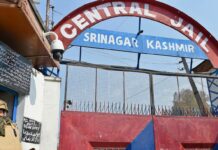A team of civil society members from New Delhi visited Kashmir after the summer unrest. In its report, it indicts the army and the government of India for turning Kashmir into a theatre of war. A Kashmir Life report.
The report of a team sent by Janhastakshep (People’s Intervention Group, Campaign Against Fascist Designs), to the valley recently, has indicted the army and Government of India for virtually turning Jammu and Kashmir into a theatre of War.
“Jammu and Kashmir has virtually been a ‘theatre of war’ for past several years with the valley area having the heaviest concentration and deployment of army and other security forces in the world,” the report said.
The report makes scathing charges against the Government of India accusing it of creating a “political class or political agents (in the state) for implementing its agenda and stage-managed successive elections to enact a drama of ‘democratic rule’ in the state”.
New Delhi-based Janhastakshep sent a team to assess the ground situation in Kashmir after a almost five-month long summer uprising. The team comprised of Prof Emeritus Amit Bhaduri, former diplomat (Mrs) Madhu Bhaduri, Supreme Court lawyer VK Ohri, Prof N Bhattacharya, Prof Ish Mishra, poet and former BBC producer Pankaj Singh and Jaspal Singh Sidhu, journalist. The team arrived in the valley on November 12, 2010, and met a cross section of people including Hurriyat leaders and Kashmiri Pandits.
The team in its report says that New Delhi has been handling the state, since 1947, as ‘law and order’ and ‘administrative’ problems.
“New Delhi deploys excessive security forces besides adopting a strategy of dividing the people on regional, linguistic and religious lines,” the report said.
Stating that security forces were empowered with a strong back-up of many ‘black laws’ of which ‘the Armed Forces Special Powers Act of 1958 (AFSPA)’ provides the military wide ranging powers to arrest, the right to shoot and kill and to occupy and/or destroy properties in ‘fake’ encounter insurgency operations.
 “The excessive and unbridled use of force alienated, humiliated and traumatized the people of Kashmir. Kashmir valley is virtually under army occupation,” the report said.
“The excessive and unbridled use of force alienated, humiliated and traumatized the people of Kashmir. Kashmir valley is virtually under army occupation,” the report said.
The Janhastakshep team has claimed that per capita troop deployment in the valley is the highest in the world, which needs huge amounts of money to maintain.
“According to an estimate, the Government of India is spending around Rs.700 crore per day on the security forces alone in this poor state,” it said.
Accusing both India and Pakistan, between whom Jammu and Kashmir is divided, of using “to the hilt this issue for their domestic politics and for raising a bogey of ultra-nationalism” the report said the conflict over J&K disturbs peace not only in this region but it influences international politics.
The report says that Human Rights and Accountability Commissions are non-existent in the state.
“Enforcement of all these black laws (AFSPA and others) virtually led to denial of Right to Life, Right to freedom of speech, assembly etc. It has resulted in inhuman and degrading behaviour of the state machinery to its own citizen,” it said. Stating that over the period, particularly from 1990 onwards around 670 odd security camps have come up in the state, majority of them in Kashmir valley, the report said that heavy militarization of the region has “resulting in death of 70,000 people and forced and involuntary disappearance of 8000”
About the exodus of Pandit community the team reported that people they interacted with in Kashmir believe that Governor Jagmohan was instrumental in creating feelings of insecurity among the Pandits in the valley that led to their mass exodus from the valley.
However, quoting a Pandit businessman in the valley it said that mass exodus of the Hindu Pandits twenty years ago was triggered by fundamentalists from within and outside the state.
The report also quotes another Kashmiri Pandit, Sanjay Tikoo, who said “How could Kashmiri Pandits have stayed back in the valley when blaring loudspeakers terrorized their womenfolk with threats of abduction to such an extent that they had to flee.” The other area of the team delved into was the exploitation of labour in Kashmir especially by the government.
“There is widespread and willful exploitation of all forms of labour: both organised and unorganised, even temporary or casual labour employed by the government are harassed and exploited. Many of the Government employees are kept temporary or casual or as contract labour for years together, and there is no one to listen to their grievances. They have no right to form union,” the report said.
As the Janhastakshep team’s visit to the valley was arranged to understand the five month summer uprising of 2010, the team reported that the killing of a boy in firing by security forces on June 11, 2010 triggered widespread clashes with unarmed young boys, girls and women coming on to streets and resorting to stone-pelting on gun-wielding security personnel.
“The Response, as usual, by the military was the gun-firing. Entire valley was under curfew for days together and the ding-dong battle between stone-pelting youth of the state and security forces continued for several months, resulted in death of 117 boys including an eight-year kid, injuring scores and detaining hundreds,” the report said.
Stating that the J&K government went into limbo with state Chief Minister, Omar Abdullah frequently running to New Delhi for ‘fresh instructions’ the report notes that “despite repressive operation by the state administration at bidding of New Delhi, the people’s demand for ‘azaadi’ (self-rule) became all the more shriller”.















